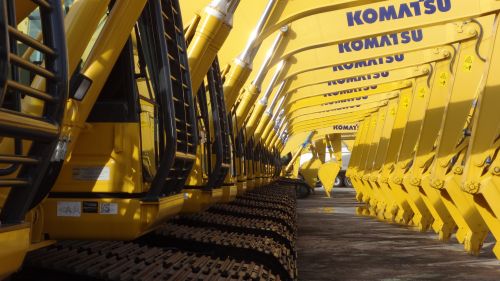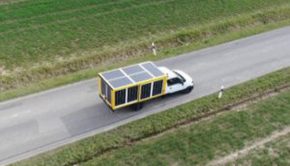Next Up for Electrification: Heavy-Duty Trucks and Construction Machinery
Next Up for Electrification: Heavy-Duty Trucks and Construction Machinery

Tesla’s Model 3 was the top-selling car in California in the first quarter of 2020, but electrified transport is not just about cars anymore.
Electric models of work trucks, commercial vehicles and construction machinery are hitting the market in greater numbers than ever before, and policymakers are growing increasingly optimistic about the sector. The California Air Resources Board (CARB), the state’s powerful air quality regulator, voted last month to require that every new truck sold in the state by 2045 be zero-emission, with truck makers forced to begin the transition in 2024.
Part of the challenge in electrifying transportation is simply getting enough desirable models on the market to attract customers and foster competition. In that realm, things are advancing: By 2023, there will be 19 all-electric or hydrogen fuel cell versions of heavy-duty trucks in production in North America, up from five Class 8 models available today, according to the Rocky Mountain Institute.
In Europe, meanwhile, there are early signs of progress on electrifying off-road construction equipment, with electric versions of excavators, loads and dumpers now available from a range of manufacturers including Hitachi, Komatsu and Volvo. Oslo launched the world’s first zero-emission construction site last year, and Norway’s capital city has mandated that by 2025 all public construction sites will operate only zero-emission construction machinery.
“The tech is becoming more capable and real,” says Bill Van Amburg, executive director of Calstart, a clean transportation advocacy group. “The business case is there for key applications and looking stronger and stronger. And then we’ve got pretty strong drivers in Europe and California.”
Add to this China’s aggressive electrification push, where early success in transit buses is expanding to include delivery vans, taxis and garbage trucks, and “in three of the largest early markets in the world, the drivers are really strong,” Van Amburg said in an interview.
Flurry of policy support for zero-emission trucks
While the U.S. still lacks a national transportation electrification strategy, state and local governments, utilities and vehicle manufacturers are helping to build the market for zero-emission trucks.
The most consequential recent development was CARB’s approval of the Advanced Clean Trucks regulation, which mandates that truck manufacturers must transition to zero-emission models starting in 2024 — the first rule of its kind in the world. All trucks sold in the state will need to be zero-emission by 2045, a rule whose impact could resonate far beyond California.
Parts of California suffer the worst air pollution in the country, including around Los Angeles. Trucks are the largest source of air pollution from vehicles, and in California they are responsible for 80 percent of the diesel soot emitted despite accounting for just 2 million of the 30 million registered vehicles in the state, according to CARB.
Local governments are beginning to take action, too: the City of Santa Monica and the Los Angeles Cleantech Incubator recently announced what could become the first U.S. zero-emission delivery zone.
Power utilities sense big opportunity in the push toward electrification. The West Coast Clean Transit Corridor Initiative, which comprises nearly a dozen electricity providers from California, Oregon and Washington, recently released a study calling for the installation of electric vehicle charging sites for freight haulers and delivery trucks every 50 miles along Interstate 5, a high-traffic north-south trade route that stretches the entire length of the West Coast.
Under the plan, 27 charging sites for medium-duty EVs would come online along the route by 2025; by 2030, 14 of the sites would add charging for electric big rigs. An additional 41 charging sites would be installed along arterial highways that feed I-5.
The vastness of North America presents challenges for vehicle electrification, however, and perhaps especially for long-haul trucks. Backers of the I-5 plan acknowledge that providing fast-charging for the largest all-electric trucks everywhere along the corridor will not be easy, as “none of the rural areas currently have capacity to serve heavy-duty site development.”
Filling the gap in U.S. national policy
Calls for broader political support for electrified trucking are growing in the U.S.
The National Zero-Emission Truck Coalition, a recently launched group of American truck makers and suppliers — including Tesla, Daimler, Proterra and Volvo Trucks — is asking Congress to offer at least $2 billion for point-of-sale incentives for zero-emission trucks and an additional $250 million annually over the next five years to support research, development and demonstration programs.
The coalition believes such congressional investment could enable the replacement of tens of thousands of diesel-powered trucks with zero-emission models by 2025.
Calstart’s Van Amburg said officials from Europe and Canada have shown interest in CARB’s new Advanced Clean Trucks regulation. Other states that have shown interest in accelerating the deployment of zero-emission trucks and buses include Connecticut, Maine, Massachusetts, New Jersey, Oregon, Rhode Island and Vermont.
China has made electrification a central industrial policy and a focus of COVID-19 recovery packages, Van Amburg notes. “We really need to, as a nation, start investing and supporting this space. We have a vital U.S. industry not only that exists today, that wants to sell to the global market, but is ready to deploy in the U.S. We need some help to jump-start the first deployment.”
There’s still work to do educating lawmakers about the viability of electric trucks, he says. “When you talk to policymakers, they’re aware of electrification — they definitely know about cars. They’re not really as aware of heavy-duty trucks being electrified.”
Amburg’s colleague, Kyle Winslow, who is Calstart’s federal policy director, said the Zero-Emission Truck Coalition will be looking for opportunities to advance its recommendations on the ground. For instance, it will explore whether point-of-sale incentives for zero-emission trucks could be piloted under existing federal programs. In the longer term, it “might mean looking at a more aggressive legislative push on a standalone bill, where we’re articulating exactly what we need if this policy is to be optimally designed.”
“We’re trying to be ready for whatever comes down the pike, given that it’s a fast-moving legislative environment with infrastructure and stimulus moving forward,” Winslow says.








